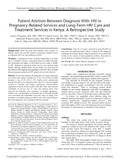| dc.description.abstract | Background: There has been little attention, until recently, to linking women who test HIV positive in pregnancy-related services to long-term HIV care and treatment services.
Methods: A retrospective review of routine hospital data was carried out in 2 hospitals in Kenya. Associations between available demographic information and uptake of HIV-related services within 6 months of HIV diagnosis in pregnancy-related services were assessed using logistic regression. Kaplan–Meier survival analysis was used to assess time between HIV diagnosis and registration at the HIV clinic. Referrals between pregnancy-related and HIV-related services were observed.
Results: At Naivasha hospital, the proportion of women registering at the HIV clinic within 6 months was 17.2% (153 of 892); at Gilgil hospital, it was 35.4% (84 of 237). Highly active antiretroviral therapy (HAART) was initiated by 40% and 27% of known eligible women in Naivasha and Gilgil, respectively. Non-systematic registration of clients on first contact at the HIV clinic, and restricted availability of services due to costs and opening hours were observed. In Naivasha, year, attendance at multiple pregnancy-related visits, and attendance at antenatal care in Naivasha hospital were associated with registration at the HIV clinic. In Gilgil, year, attendance at multiple pregnancy-related visits, and women being in their first pregnancy were associated with the outcome.
Conclusions: Only 4% of women estimated to need HAART for their own care initiated HAART within 6 months of HIV diagnosis. Challenges associated with providing longitudinal care are especially evident in the context of high population mobility. Innovation in service delivery is required to improve uptake of services | en_US |

